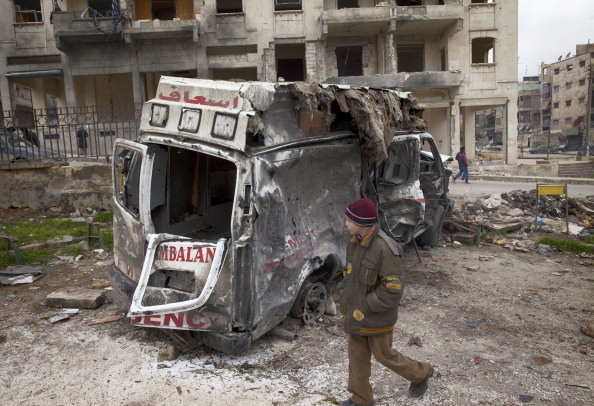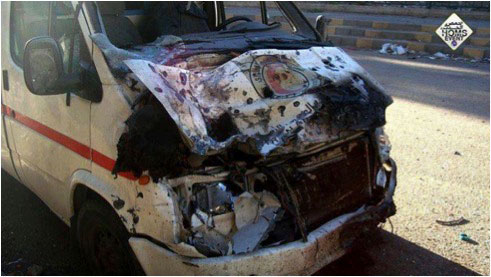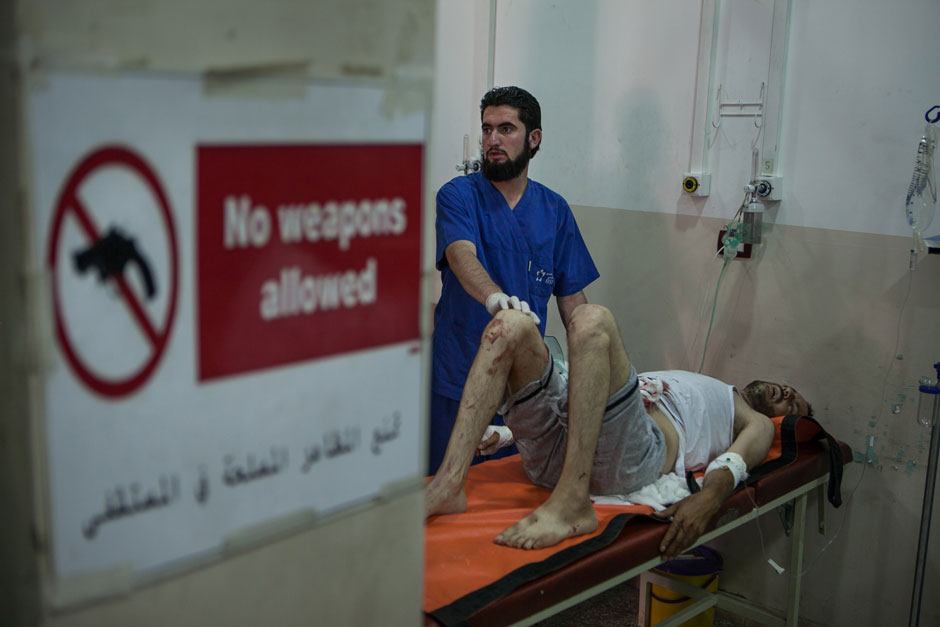Over the last few weeks, the growing plight of Syria’s civilian population has drawn belated international attention to the country’s failing health system. In late October, in the eastern part of the country, the World Health Organization confirmed an outbreak of polio—a highly infectious, fast-spreading disease that poses a potential threat not just to Syria but to the entire region. At the same time, reports of malnutrition and disease in the besieged areas on the outskirts of Damascus and other embattled cities, where there are severe shortages of food and milk, have raised new fears of a spreading public health disaster. But these developments are hardly new, nor are they, as the international press has suggested, simply the unfortunate byproducts of an increasingly brutal war. They are connected to something far more sinister: a direct assault on the medical system by the Syrian government as a strategy of war.
The Assad regime has come to view doctors as dangerous, their ability to heal rebel fighters and civilians in rebel-held areas a weapon against the government. Over the past two and a half years, doctors, nurses, dentists, and pharmacists who provide treatment to civilians in contested areas have been arrested and detained; paramedics have been tortured and used as human shields, ambulances have been targeted by snipers and missiles; medical facilities have been destroyed; the pharmaceutical industry devastated. Directly and indirectly, the attacks have had a profound effect on tens of thousands of health professionals and millions of Syrian patients, let alone the more than 2 million refugees who have fled to neighboring countries.
Here is how a surgeon from Aleppo describes the attitude of the Syrian government. Last April, while treating a man seriously wounded by a government sniper, he was accosted and wrenched away by a military intelligence officer: “We are shooting at them in order to kill them. This is obvious,” the intelligence officer told him. “Since you are stopping him from dying, you are a terrorist. For this you will be punished.” The surgeon’s clinic was destroyed, his wife’s clinic was shut down, and they were forced to flee Aleppo. As a surgeon, he is not authorized to practice in Turkey, where they have taken refuge, despite the urgent need of his skills there.
In the northwest city of Idlib, the Red Crescent hospital was simply taken over by the Syrian army after a systematic crackdown on its medical staff. Before the war, the hospital had some twenty doctors and forty nurses. By March 2012, when the army arrived, there were only three doctors left—two anesthetists and a surgeon—and two nurses. The hospital’s director, Dr. Abdulrazaq Jbero, had been killed a few weeks earlier by a government sniper on his way back from Damascus in a Red Crescent vehicle. The lone remaining surgeon recalled the army siege that followed:
We were detained in the hospital for several days. Tanks parked out front, artillery in the wards, snipers on the roofs shooting patients who tried to come. They took our names, and summoned three of the five security branches—state, political and military. I was interrogated and forced to sign several commitments not to treat anyone not pro-regime. Of course, as soon as I was released I violated it immediately…the city was full of wounded and sick people. Soon after that a friend who worked in military security let me know I was now “wanted” [for my work], the charge being that I was the leader of a terrorist group. So I went into hiding, and moved my family to Turkey. In retaliation my brother was executed. He wasn’t even an activist. He was a physical-education teacher and the father of four children. He was killed with ten bullets.
On October 24, A UN rapporteur reported that “32 of the country’s 88 public hospitals have closed because of the ongoing conflict, and government and pro-government forces have arbitrarily detained, tortured, and killed hundreds of health workers and patients.” In fact, from my research, the correct number of hospitals that have been shut down is closer to fifty—many of them in contested areas or in areas outside of government control. Five public hospitals have been taken over by the military, and there are no longer any left at all in the rebel-dominated cities of Idlib and Deir Ezzor. Fewer than forty ambulances in the country still function out of the original fleet of five hundred.
At the beginning of 2011, there were more than 30,000 doctors practicing in Syria. Now, more than 16,000 doctors have fled, and many of those left are in hiding. Of the more than 160 doctors killed since the conflict began, more than ninety have been assassinated for doing their jobs; some had been placed on “wanted” lists. At least thirty-six paramedics, in uniform on authorized missions, have been killed by Syrian military snipers or shot dead at checkpoints. In areas contested or controlled by rebels, such as Homs and Aleppo, branches of the Syrian Arab Red Crescent have been shelled. When government forces stormed the city of Deir Ezzor in June 2012, they informed Dr Ghassam Shoubet at the Deir Ezzor branch of the Red Crescent, “It is forbidden to carry out any first aid activities.” Emergency medical squads are routinely prevented from evacuating not only wounded rebel fighters but also injured children and other civilians from rebel-held territory.
Advertisement
Over the last few months, in the border regions of Lebanon and Turkey, I have conducted nearly two-hundred interviews with Syrians and Palestinians, Alawites and Sunnis, Kurds and Christians, Shias and Ismaelis, rebel fighters and regime militiamen, doctors and nurses, pharmacists and relief workers, children and civilians. Far from limiting the effects of the conflict on civilians, Bashar al-Assad’s counterinsurgency strategy appears to be deliberately targeting the civilian population and medical facilities in rebel areas, in order to deprive the armed opposition of its support.
The first attacks on doctors and first aid workers occurred in the opening months of the uprising: in April 2011, a doctor in Daraa was assassinated, and in July 2011, Syrian forces began detaining doctors and pharmacists in Homs and other contested areas. In September of that year, the first intentional attack on a clearly-marked ambulance occurred, in Homs. Hakim, the team leader of that first aid squad, describes what happened:
We were going to the site of a battle to pick up some injured rebel soldiers. Our crew was well known to the officer, and had a long history of evacuating both government and rebel combatants with wounds. He cleared us at the checkpoint to cross over. We picked up three injured rebels in Al-Hamidya. But when we came back through the checkpoint, the same officer opened fired with a machine gun, hitting the ambulance with thirty-two bullets. Nine of the bullets hit my friend Hakam Al-Subai, a twenty-five-year-old banker who had become a paramedic. He died a week later. I was hit by four bullets, another volunteer had two bullets, one of the soldier’s wounds became a life-threatening injury.
In 2012, such attacks became increasingly widespread, and on July 2, 2012, the Syrian government passed an anti-terrorism law that effectively made it a crime to provide medical care to anyone suspected of being part of the opposition. As an investigation by the Human Rights Council concluded in September of this year, “By attacking medical facilities, using hospitals as bases for military action, targeting medical personnel and interfering with patients receiving treatment, Government forces have perpetrated a concerted policy of denying medical aid to those affiliated with or part of the armed opposition.”
Many doctors I interviewed described being forced to deny treatment to people in need or to treat them covertly, fearing detention or worse. Others recounted the efforts of the government to prevent the provision of medicine in contested areas. Dr. K., a pharmacist from Idlib governorate, said:
I used to give medicine to anyone who was injured, whether it was the regime or the free army….When the regime found this out, in February last year, my name was put on the “wanted list.” This list is given to all the public hospitals and centers under regime control, so that if you go there for treatment, they will check, and detain you. My pharmacy was looted and then destroyed, my warehouse raided and taken over. It’s still occupied by the regime, they use it as a watchtower.
The deliberate destruction of pharmacies affects more than the war-wounded. It means people risk dying of hypertension and heart disease. No contraception and the deprivation of basic supplements such as iron and folic acid cause unplanned and riskier pregnancies at a time when maternal care is denied. The Syrian American Medical Society estimates 200,000 excessive deaths as a result of lack of routine medications for diabetes, heart disease, chronic lung disease, and cancer.
The government strategy is further revealed by comparing the current state of medical care in opposition- and government-held areas. Before the uprising began, there were free public hospitals and sophisticated specialists throughout the country, and medications were accessible and affordable. Now, the healthcare system has become two-tiered. While medical supplies have become limited, in government-controlled areas there are doctors and nurses staffing functioning hospitals. There is electricity for operating room lights, incubators, dialysis machines, and ventilators. There are laboratory services, CT machines, and bloodbanks for injured combatants, antenatal care for women, and vaccines for children.
For the millions of civilians in opposition areas, in particular the governorates of Homs, Aleppo, Idlib, and Deir Ezzor, and in certain suburbs of Damascus, it’s a different matter. Destruction of power plants by the Syrian army means no electricity, making it impossible to maintain a cold-chain for vaccines. X-Ray machines and operating room lights are dependent on generators. The makeshift “field hospitals” that have replaced destroyed or occupied hospitals in many areas have more in common with fields than hospitals. Some are in basements or mosques, others in tents and caves. Patients can have a hard time even finding these clinics, because they must move regularly or go underground to evade aerial surveillance and attacks.
Advertisement
When the injured do manage to reach a clinic, there are often no medical supplies or intravenous fluids to care for them. Aleppo’s blood bank, which is responsible for the northern region of Syria, was bombed in July 2012; since then, there is no blood supply, nor even blood bags to receive blood. Cross-matching of blood, once routine, can no longer be done; in one clinic alone this year three patients died not of their blast injuries, but from reactions to blood transfusions. Surgeons must often donate blood themselves. And patients dare not stay long for fear of being attacked or detained and forced to give names of the doctors who cared for them.
Direct attacks on medical workers and patients are not only appalling, they also violate the Geneva Conventions. The principle of medical neutrality—according to which that wounded and sick combatants have the right to receive aid, and doctors, pharmacists, first responders, and relief workers have the right to give it—was codified in international law with the first Geneva Convention in 1864. Syria ratified the most recent version of the Geneva Conventions in 1957, which states that civilians may not be targeted, and nothing that is vital to the lives of civilians may be destroyed. Medical neutrality has been violated in other recent conflicts—hospitals were attacked in Bosnia, doctors killed in Cambodia, and aid workers have been targeted in Afghanistan, Pakistan, Somalia and elsewhere. But the scale of the violations in Syria is without precedent in recent history.
The World Health Organization estimates there are now half a million Syrians with war injuries; but the assault on the medical system has meant that many have received astonishingly poor treatment. I talked with not only fighters, but also civilian men, women, and children as young as five with paralyzed bodies, useless hands, missing legs and arms, disfigured faces. Many still had shrapnel embedded in their spines and brains. A spinal injury shouldn’t necessarily result in paralysis, lacerations needn’t yield loss of limbs or function. Yet specialized care to reattach limbs, repair nerves, restore function, and undertake reconstructive surgery is now consistently available only in government-controlled hospitals. For many of the wounded, lack of antibiotics, combined with the long delay in access to treatment, has led to gangrene and progressively higher amputations.
Madir, a fourteen-year-old girl described what had happened to her a few months earlier in June 2013:
I was alone when it happened, on my way to visit my uncle outside of Aleppp. It was Monday afternoon, at 2 o’clock. Two rockets came, but I was on the street, there was nowhere to hide. When I tried to stand up I fell over—and I saw my foot coming apart from my leg. Some people picked me up and put me in a car. They didn’t even try to call an ambulance, there aren’t any left here. The first two hospitals refused me, saying there was no doctor. The third one, there was a surgeon. By this time it was 7 o’clock, but I couldn’t even pass out, I wanted my mom. I don’t have a dad. Later, I found out she had to go to every single hospital to find me. I lost consciousness. When I woke up, my foot was gone. Later, the surgeon told me that he had tried very hard, and he gave me as much blood as he could—3 times—but that over the next fifteen days since the injury I had lost too much blood, that my heart had stopped for a while, and so he had to take away my leg.
Handicap International has estimated that the rate of amputations and spinal cord injuries in Syria is roughly double that of other wars. According to patients, doctors, and former soldiers I interviewed, a small but definite number of the spinal cord injuries appear to be deliberate, reflecting one apparent military strategy of shooting not to kill but to paralyze by targeting combatants in the spine. Men are deprived of the ability to walk, fight, have intercourse, and exercise basic bodily functions such as bladder and rectal control—a lifelong humiliation.
A still greater threat to the Syrian population could be the rampant spread of controllable diseases. Water is still running from the taps, but the regime’s withholding of chlorine in contested areas means it is no longer treated to eliminate water-borne disease. Trash collection has ceased, yielding breeding sites for vectors of disease. Denial of vaccination to infants and children means outbreaks of measles, rubella, diphtheria, tetanus, hepatitis, and now even polio. The doctors that remain, more familiar with diabetes than dysentery, are ill equipped to deal with typhoid and tuberculosis. As a middle-income country, Syria had long since gone through the “epidemiological transition,” when non-communicable diseases (such as diabetes and cancer, heart disease and high blood pressure, allergies and asthma) overtake infectious diseases as the major causes of death. Now that trend has been reversed.
“I used to see cancer patients,” one Syrian pediatrician told me. “Now I see diphtheria and polio. These are diseases we had forgotten.” Before the conflict began, polio had not been seen in Syria since last century. And all of the cases are in children under age five, all in contested areas denied the standard immunization schedule still afforded to children in areas controlled by the Syrian government. Along with other communicable diseases, the risk of polio has been made worse by malnutrition in many besieged opposition-held areas, where humanitarian workers are denied access by the regime.
And then there is leishmaniasis, an exceptionally nasty parasitic disease spread by sand flies. Left untreated, it leads to horrible facial scarring. It is not a disease of poverty, but of war. Sand flies are predisposed to areas of conflict, breeding in the rubble of buildings destroyed by bombs. Neither great fliers nor jumpers, they are normally restricted to biting people who live at ground level. Bombing apartment buildings not only brings the whole population down to the ground level where sand flies live, but also creates the rubble in which these insects thrive. Combined with lack of shelter, and piles of trash, this creates the perfect conditions for a leishmaniasis epidemic. In 2007 there were fewer than 18,000 cases, and medications were freely available. Now, there are well over 100,000 cases in Aleppo alone. It is reminiscent of Afghanistan in the 1990s, where there was a direct correlation between the level of leishmaniasis and the amount of destruction, and where little girls ended up at the bottom of wells, unmarriageable because of the facial scarring.
The assault on the health system has become a weapon of mass destruction, transforming Syria into a country with diseases of poverty and war. The only appropriate international response to this tragedy is for the UN Security Council to insist that the Syrian government allow safe humanitarian access to the areas of the country most in need and respect medical neutrality for all medical care workers. In October, for the first time, the UN Security Council issued a presidential statement, with Russian support, that condemned attacks on medical care in Syria. In view of its close ties with the Assad regime, Russia should be pushed to insist that the Syrian government release detained doctors and healthcare workers, lift the siege that undermines medical care, and stop impeding the provision of aid impartially to all in need. Clear pressure from Putin may be the only way to convince Assad that his war strategy is turning his country into one of the world’s most underdeveloped nations.





